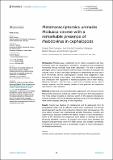Por favor, use este identificador para citar o enlazar a este item:
http://hdl.handle.net/10261/331854COMPARTIR / EXPORTAR:
 SHARE SHARE
 CORE
BASE CORE
BASE
|
|
| Visualizar otros formatos: MARC | Dublin Core | RDF | ORE | MODS | METS | DIDL | DATACITE | |

| Campo DC | Valor | Lengua/Idioma |
|---|---|---|
| dc.contributor.author | Rey-Campos, Magalí | es_ES |
| dc.contributor.author | González-Vázquez, Luis Daniel | es_ES |
| dc.contributor.author | Novoa, Beatriz | es_ES |
| dc.contributor.author | Figueras Huerta, Antonio | es_ES |
| dc.date.accessioned | 2023-07-26T07:03:54Z | - |
| dc.date.available | 2023-07-26T07:03:54Z | - |
| dc.date.issued | 2023 | - |
| dc.identifier.citation | Frontiers in Marine Science 10: 1209103 (2023) | es_ES |
| dc.identifier.uri | http://hdl.handle.net/10261/331854 | - |
| dc.description | 14 pages, 7 figures, 2 tables.-- This is an open-access article distributed under the terms of the Creative Commons Attribution License (CC BY) | es_ES |
| dc.description.abstract | [Introduction] Mollusks play a significant role in marine ecosystems and have economic value for aquaculture. Sometimes, unexpected and unexplained mortalities among mollusks have been described. The role of potential pathogens such as viruses remains unknown due to the lack of molluscan cell cultures, which is one of the major drawbacks to determining the viral role in such mortalities. Several oceanographic studies have suggested a high abundance of viruses in the oceans. Virus identification and understanding of viral interaction with organisms in marine ecosystems are in their infancy. Metatranscriptomics could become a useful tool to identify viruses using a shotgun approach and the growing number of viral genomes and sequences deposited in public databases. [Methods] In this work, several bioinformatics approaches were set up to screen Mollusca RNA sequences to find and confirm viral traces in their transcriptomes. This meta-analysis included an extensive search of SRA datasets belonging to mollusks available in the NCBI database, selecting a total of 55 SRA datasets that were further analyzed searching for viral sequences. [Results] Twenty-two bivalves, 19 cephalopods and 16 gastropods from 16 geographical origins and 17 different tissues were considered. The domain search approach was the most productive method to find viral sequences. This virus search showed that Cephalopoda samples (Idiosepius notoides and Amphioctopus fangsiao) exhibited the highest number of virus identifications. Some of the detected viral sequences were similar or identical to others previously identified. However, 33 putative new viruses were identified and analyzed phylogenetically when the RdRp domain was available. Specifically, Cephalopoda samples showed a considerable number of viruses belonging to the Rhabdoviridae family | es_ES |
| dc.description.sponsorship | Our research was funded by the Ministerio de Ciencia e Innovación (PID2021-124955OB-I00) and Xunta de Galicia (IN607B 2022/13) | es_ES |
| dc.language.iso | eng | es_ES |
| dc.publisher | Frontiers Media | es_ES |
| dc.relation.isversionof | Publisher's version | es_ES |
| dc.relation.isbasedon | The underlying dataset has been published as supplementary material of the article in the publishers platform at DOI https://doi.org/10.3389/fmars.2023.1209103 | es_ES |
| dc.rights | openAccess | es_ES |
| dc.subject | Mollusks | es_ES |
| dc.subject | Virome | es_ES |
| dc.subject | Abundance | es_ES |
| dc.subject | Diversity | es_ES |
| dc.subject | Metatranscriptomics | es_ES |
| dc.subject | RNA-Seq | es_ES |
| dc.subject | Genomics | es_ES |
| dc.title | Metatranscriptomics unmasks Mollusca virome with a remarkable presence of rhabdovirus in cephalopods | es_ES |
| dc.type | artículo | es_ES |
| dc.identifier.doi | 10.3389/fmars.2023.1209103 | - |
| dc.description.peerreviewed | Peer reviewed | es_ES |
| dc.relation.publisherversion | https://doi.org/10.3389/fmars.2023.1209103 | es_ES |
| dc.identifier.e-issn | 2296-7745 | - |
| dc.rights.license | https://creativecommons.org/licenses/by/4.0/ | es_ES |
| dc.contributor.funder | Ministerio de Ciencia e Innovación (España) | es_ES |
| dc.contributor.funder | Xunta de Galicia | es_ES |
| dc.relation.csic | Sí | es_ES |
| oprm.item.hasRevision | no ko 0 false | * |
| dc.identifier.funder | http://dx.doi.org/10.13039/501100004837 | es_ES |
| dc.identifier.funder | http://dx.doi.org/10.13039/501100010801 | es_ES |
| dc.type.coar | http://purl.org/coar/resource_type/c_6501 | es_ES |
| item.grantfulltext | open | - |
| item.fulltext | With Fulltext | - |
| item.openairecristype | http://purl.org/coar/resource_type/c_18cf | - |
| item.languageiso639-1 | en | - |
| item.cerifentitytype | Publications | - |
| item.openairetype | artículo | - |
| Aparece en las colecciones: | (IIM) Artículos | |
Ficheros en este ítem:
| Fichero | Descripción | Tamaño | Formato | |
|---|---|---|---|---|
| Metatranscriptomics_unmasks_OA_2023.pdf | 3,79 MB | Adobe PDF |  Visualizar/Abrir | |
| Image 1.TIF | 533,3 kB | TIFF |  Visualizar/Abrir | |
| Table 1.XLSX | 14,75 kB | Microsoft Excel XML | Visualizar/Abrir | |
| Table 2.XLSX | 453,08 kB | Microsoft Excel XML | Visualizar/Abrir | |
| Table 3.XLSX | 9,98 kB | Microsoft Excel XML | Visualizar/Abrir | |
| Table 4.XLSX | 41,17 kB | Microsoft Excel XML | Visualizar/Abrir | |
| Table 5.XLSX | 14,8 kB | Microsoft Excel XML | Visualizar/Abrir | |
| Table 6.XLSX | 41,74 kB | Microsoft Excel XML | Visualizar/Abrir |
CORE Recommender
Page view(s)
154
checked on 22-may-2024
Download(s)
150
checked on 22-may-2024
Google ScholarTM
Check
Altmetric
Altmetric
Este item está licenciado bajo una Licencia Creative Commons

